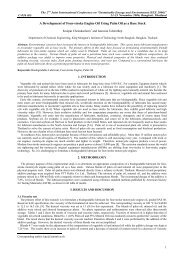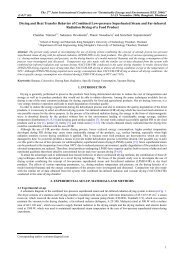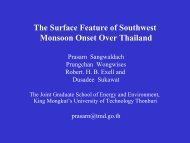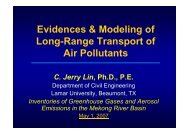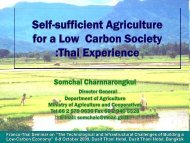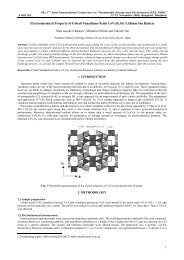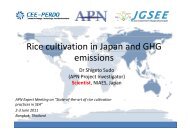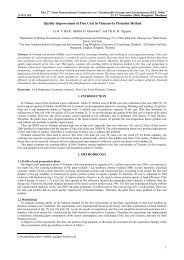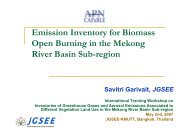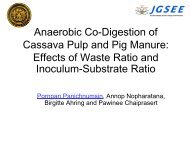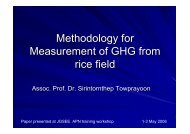The Determination of Palembang Climate Type by Using Schmidt ...
The Determination of Palembang Climate Type by Using Schmidt ...
The Determination of Palembang Climate Type by Using Schmidt ...
You also want an ePaper? Increase the reach of your titles
YUMPU automatically turns print PDFs into web optimized ePapers that Google loves.
<strong>The</strong> 2 nd Joint International Conference on “Sustainable Energy and Environment (SEE 2006)”<br />
D-013 (O) 21-23 November 2006, Bangkok, Thailand<br />
<strong>The</strong> <strong>Determination</strong> <strong>of</strong> <strong>Palembang</strong> <strong>Climate</strong> <strong>Type</strong> <strong>by</strong> <strong>Using</strong> <strong>Schmidt</strong>-Ferguson Method<br />
Muhammad Irfan *<br />
Physics Department, Sriwijaya University, <strong>Palembang</strong>, Indonesia<br />
Abstract: <strong>The</strong> climate is an important component <strong>of</strong> ecosystem, because the climate could influence the human life. <strong>Schmidt</strong> and<br />
Ferguson have divided the climate at tropics into 8 types. Each type <strong>of</strong> them has special characteristic and special impact to human<br />
existence. <strong>The</strong>refore the type <strong>of</strong> climate is very important to know. <strong>The</strong> purpose <strong>of</strong> this research is to determine the type <strong>of</strong> <strong>Palembang</strong><br />
climate <strong>by</strong> using the <strong>Schmidt</strong>-Ferguson method. This method needs data <strong>of</strong> the rainfall amount at least for 30 years. <strong>The</strong> data which is<br />
used in this research is the monthly data in <strong>Palembang</strong> since year 1965 until year 2000. <strong>The</strong> result <strong>of</strong> this research is <strong>Palembang</strong> has<br />
the very wet climate.<br />
Keyword: <strong>Climate</strong> <strong>Type</strong>, <strong>Schmidt</strong>-Ferguson Method, Rainfall, Wet Month, Dry Month<br />
1. INTRODUCTION<br />
<strong>The</strong> earth's climate is generally defined as the average weather over a long period <strong>of</strong> time [1]. A place or region's climate<br />
determined <strong>by</strong> both natural and anthropogenic (human-made) factors. <strong>The</strong> natural elements include the atmosphere, geo-sphere,<br />
hydrosphere, and biosphere, while the human factors include land and resource uses. Changes in any <strong>of</strong> these factors can cause local,<br />
regional, or even global changes in the climate. Weather is the current atmospheric conditions, including temperature, rainfall, wind,<br />
and humidity at a given place. If you stand outside, you can see that it's raining or windy, or sunny or cloudy. You can tell how hot it<br />
is <strong>by</strong> taking a temperature reading. Weather is what's happening right now or is likely to happen tomorrow or in the very near future.<br />
<strong>Climate</strong>, on the other hand, is the general weather conditions over a long period <strong>of</strong> time. Some meteorologists say that "climate is<br />
what you expect and weather is what you get. <strong>Climate</strong> is sometimes referred to as "average" weather for a given area.<br />
<strong>The</strong>re are many differences <strong>of</strong> climates around the world, divided into climate zones. <strong>The</strong>y include tropical, desert, temperate and<br />
polar climates. <strong>The</strong>se exist because different parts <strong>of</strong> the Earth receive different amounts <strong>of</strong> sunlight. <strong>The</strong> Sun is stronger nearer the<br />
equator and weaker nearer the poles. Near the equator (like Indonesia), the Sun can be overhead during the middle <strong>of</strong> the day, heating<br />
the surface very strongly. Even during the winter, sunlight near the equator is strong and temperatures rarely fall below 25°C during<br />
any time <strong>of</strong> the year. This part <strong>of</strong> the world is called the tropics. <strong>The</strong>y are warm, humid and receiving a lot <strong>of</strong> rainfall, particularly<br />
during their wet season, that can occurred once or twice each year. <strong>The</strong> daytime temperature in the tropics rarely falls below 25°C,<br />
even in winter, and nights are generally almost as warm.<br />
<strong>Schmidt</strong> and Ferguson have determined the type <strong>of</strong> climate at tropics based on the calculation <strong>of</strong> the number <strong>of</strong> dry month and wet<br />
month. <strong>The</strong>y used the Mohr method for determining the wet month and the dry month. <strong>The</strong> aim <strong>of</strong> this research is to determine the<br />
type <strong>of</strong> <strong>Palembang</strong> climate <strong>by</strong> using the <strong>Schmidt</strong>-Ferguson method. <strong>The</strong> data is the amount <strong>of</strong> monthly rainfall in <strong>Palembang</strong> since<br />
year 1965 until year 2000.<br />
2. METHODOLOGY<br />
This research has been done at <strong>Palembang</strong> Weather Service on November 2002. <strong>The</strong> data is the amount <strong>of</strong> rainfall monthly in<br />
<strong>Palembang</strong> for 36 years (1965-2000). <strong>The</strong> steps <strong>of</strong> the research are:<br />
a. to calculate the number <strong>of</strong> wet month and dry month in every year<br />
b. to calculate the yearly average <strong>of</strong> wet month and dry month for 36 years (1965-2000)<br />
c. to calculate the Q value.<br />
d. to determine the type <strong>of</strong> <strong>Palembang</strong> climate based on Q value.<br />
<strong>Schmidt</strong> and Ferguson used the Mohr method for determining the wet month and the dry month. According to the Mohr method:<br />
a. if the amount <strong>of</strong> rainfall on one month is more than 100 mm, that month is named wet month,<br />
b. if the amount <strong>of</strong> rainfall on one month is less than 60 mm, that month is named dry month,<br />
c. if the amount <strong>of</strong> rainfall on one month is between 60 mm and 100 mm, that month is named moist month.<br />
<strong>Schmidt</strong> and Ferguson calculated the number <strong>of</strong> wet month and dry month every year at least for 30 years, and than took the<br />
average value <strong>of</strong> them. For determining the type <strong>of</strong> climate, they used the formulation [3]:<br />
D<br />
Q = , (1)<br />
W<br />
where W is average number <strong>of</strong> wet month and D average number <strong>of</strong> dry month<br />
Based on the Q value, they determined the type <strong>of</strong> climate into 8 zones and 8 types <strong>of</strong> climate, that are [3]:<br />
Corresponding Author: irfplg@yahoo.com<br />
1
<strong>The</strong> 2 nd Joint International Conference on “Sustainable Energy and Environment (SEE 2006)”<br />
D-013 (O) 21-23 November 2006, Bangkok, Thailand<br />
Table 1 <strong>The</strong> type <strong>of</strong> climate based on Q value.<br />
Q VALUE ZONE TYPE OF CLIMATE<br />
< 0.14 A Very Wet<br />
0.14 – 0.33 B Wet<br />
0.33 – 0.60 C Rather Wet<br />
0.60 – 1.00 D Medium<br />
1.00 – 1.67 E Rather dry<br />
1.67 – 3.00 F Dry<br />
3.00 – 7.00 G Very dry<br />
> 7.00 H Extraordinarily dry<br />
3. RESULTS AND DISCUSSION<br />
From the data <strong>of</strong> monthly rainfall amount in <strong>Palembang</strong> city for 36 years (432 months) we found that:<br />
a. Number <strong>of</strong> wet month is 337 months<br />
b. Number <strong>of</strong> dry month is 46 months<br />
c. Number <strong>of</strong> moist month is 49 months<br />
So that, the Average number <strong>of</strong> wet month (W) is:<br />
and Average number <strong>of</strong> dry month (D) is:<br />
<strong>The</strong> Q number is:<br />
337 W = = 0.7800 ,<br />
432<br />
(2)<br />
46 D = = 0.1065 .<br />
432<br />
(3)<br />
0.1065<br />
Q = = 0.1365 .<br />
0.7800<br />
(4)<br />
Based on Tabel 1, if Q < 0.14, the area is on A zone and has a very wet climate type. <strong>The</strong>refore we could make a conclusion that<br />
<strong>Palembang</strong> has a very wet climate type.<br />
<strong>The</strong> characteristics <strong>of</strong> very wet climate are [2]:<br />
a. <strong>The</strong> air temperature is hot<br />
b. <strong>The</strong> rain precipitate is about 2.500 mm yearly<br />
c. It has two season, that are rainy season and dry season<br />
d. It has two transititon time from rainy season to dry season and from dry season to rainy season<br />
e. It has the uniform air temperature which is around 27 0 C.<br />
If we look at to the characteristics <strong>of</strong> those, <strong>Palembang</strong> has rainy season and dry season, and two transition time <strong>of</strong> that season. It is<br />
appropriate to the fact. However, it is still needed to do the research about period <strong>of</strong> the transition time.<br />
4. ACKNOWLEDGMENTS<br />
<strong>The</strong> authors gratefully acknowledge the contribution <strong>of</strong> Mr. Arsali and Mrs. Indah Irfan.<br />
5. CONCLUSION<br />
<strong>Palembang</strong> has a very wet climate. It means that <strong>Palembang</strong> has: hot air temperature, about 2.500 mm <strong>of</strong> yearly rain precipate,<br />
rainy season and dry season, two transititon time <strong>of</strong> season, and around 27 0 C <strong>of</strong> air temperature.<br />
6. REFERENCES<br />
[1] Prawirowardoyo, S. (1996) Meteorologi, Penerbit ITB, Bandung, Indonesia.<br />
[2] Rafi’i, Suryatna. (1995) Meteorologi dan Klimatologi, Penerbit Angkasa, Bandung, Indonesia.<br />
[3] Tjasjono, B. (1999) Klimatologi Umum, Penerbit ITB, Bandung, Indonesia.<br />
[4] Ward, R.C & Robinson, M. (1990) Principles <strong>of</strong> Hidrology, 3 th edition, McGraw-Hill Book Company Europe, England.<br />
2



